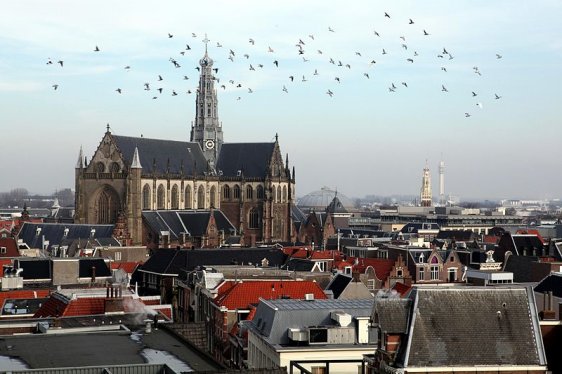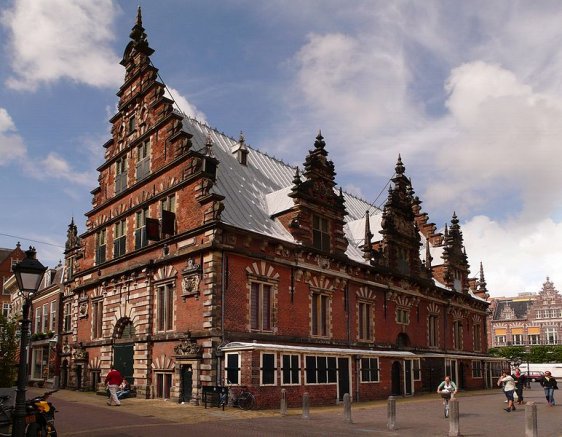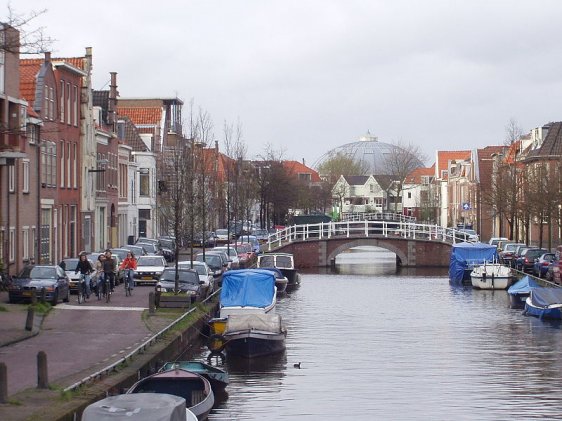
Haarlem, Netherlands
Source: https://commons.wikimedia.org/wiki/File:Haarlem-Bakenessergracht_vanaf_Het_Spaarne.jpg
Author: Jane023

Haarlem is the capital of the province of North Holland, in the Netherlands. It covers 32.09 sq km (12.4 sq mi) and has a populaiton of 151,000 (2011 estimate). This is the city that gave its name to Harlem in New York City. It is today the eighth largest city in the country, located in the northern part of Randstad, the sixth largest metropolitan area in Europe. Haarlem is about 20 km to the west of Amsterdam, on the river Spaarne. It is often called Bloemenstad, or "flower city", as it is in the heart of the tulip-growing region of the Netherlands.

St Bavokerk, Haarlem
Source: https://commons.wikimedia.org/wiki/File:De_Grote_of_St._Bavokerk_te_Haarlem.jpg
Author: Fc3003

The earliest mention of Haarlem was in the 10th century. In 1219, as a reward for conquering the Egyptian port of Damietta (present-day Dimyat), the knights of Haarlem were honored by Count Willem I. The early town, built mostly of wood, was burnt down in 1328. The fire also severely damaged the Sint-Bavokerk church, which has since been rebuilt.
In 1381 Haarlem was also struck by the Black Death, which killed half its population. Then that time, it was becoming the second largest city in the then Holland region, and the sixth largest in the Netherlands. Haarlem was captured by the Spanish after a long siege in 1573. The Spanish ruled the city until 1577 when under the Agreement of Veere, the Protestants and Catholics of the city were given equal rights.

Vleehals, Haarlem
Source: https://commons.wikimedia.org/wiki/File:Haarlem_Vleeshal1_.jpg
Author: Welleschik

By the 17th century, Haarlem was becoming a center for the linen and silk industries. At the same time, the first tow canal between Haarlem and Amsterdam was built. The city attracted painters, particularly after the fall of Antwerp.
Haarlem's position as a trading town decline in the 18th century, as the center of trade shifted to Amsterdam. By then its textile industry was in decline, brought down by stiff overseas competition.
Haarlem was severely devastated by the Second World War. Its Jewich community was decimated, their trials documented by Corrie ten Boom. After the war, the city was repopulated by immigrants, the majority coming from the former Dutch colony of Indonesia. The city continued to reinvent itself.

Burgwal, Haarlem
Source: https://commons.wikimedia.org/wiki/File:Burgwal_Haarlem.jpg
Author: Metro Centric

Today Haarlem is a center for printing, pharmaceuticals and the tulip-growing industries. The old market square, Grote Markt, is in the heart of the city, and most of the tourist attractions are within walking distance from there.
Visiting Haarlem
If you arrive in Schiphol Airport, you need to first take a train to Amsterdam main train station and then change to the train for Haarlem. Alternatively you can take a bus (the big red bus 300) from Schiphol direct to Haarlem Central Station.Places of Interest in Haarlem
- Amsterdamse Poort
One of the medieval gates into Haarlem, built in 1355, with ornamentation added in the 15th century. - Frans Hals Museum
Museum celebrating the works of Frans Hals (1582-1666), regarded as the first "modern" artist who introduced new realism into painting. - Grote Kerk
The main church of Haarlem, built in the Gothic style is the subject of many Dutch paintings. - Grote Markt
The central market square of Haarlem, today occupied by restaurants and cafes. - Haarlem Station
Station for the first railway line between Amsterdam and Haarlem. Originally opened in 1839, it was refurbished in 1905 in the Art Nouveau style. - Historisch Museum Haarlem
Museum featuring the history of the city is housed in a former almshouse, built to help the poor and destitute. - Laurens Coster's Statue
The people of Haarlem believe that Laurens Coster invented printing in 1423, 16 years before Gutenberg did so. This statue celebrated the claim. - Stadhuis
The Harlem town hall has a figure of Justice at the main entrance, carrying a sword and the scales of justice. - Teylers Museum
Established in 1778 by silk merchant Pieter Teyler, this is the first major public museum in the country. - Verweyhal
Museum for Modern Art located at the Grote Markt, is part of the Frans Hals Museum. It is named after Dutch painter Kees Verwey. - Vleeshal
Historic building at the Grote Markt. It used to be the meat market but today houses temporary exhibits of modern art.
Haarlem is  on the map of the Netherlands
on the map of the Netherlands
 Latest updates on Penang Travel Tips
Latest updates on Penang Travel Tips
 Discover with Timothy YouTube Channel
Discover with Timothy YouTube Channel
 PG Food Channel
PG Food Channel
 Learn Penang Hokkien YouTube Channel
Learn Penang Hokkien YouTube Channel
 SojiMart Videos
SojiMart Videos
Latest from Discover with Timothy: Gurney Bay - what to see and do there
About this website

Hello and thanks for reading this page. My name is Timothy and my hobby is in describing places so that I can share the information with the general public. My website has become the go to site for a lot of people including students, teachers, journalists, etc. whenever they seek information on places, particularly those in Malaysia and Singapore. I have been doing this since 5 January 2003, for over twenty years already. You can read about me at Discover Timothy. By now I have compiled information on thousands of places, mostly in Peninsular Malaysia and Singapore, and I continue to add more almost every day. My goal is to describe every street in every town in Malaysia and Singapore.
Robbie's Roadmap
- Episode 1: Robbie's Journey to Financial Freedom
- Episode 2: Lost in America
- Episode 3: The Value of Money
- Episode 4: The Mentor
- Episode 5: The Thing that Makes Money
- Episode 6: The walk with a Billionaire
- Episode 7: The Financial Freedom Awakening
- Episode 8: Meet Mr Washington
- Episode 9: The Pizzeria Incident
Copyright © 2003-2024 Timothy Tye. All Rights Reserved.


 Go Back
Go Back